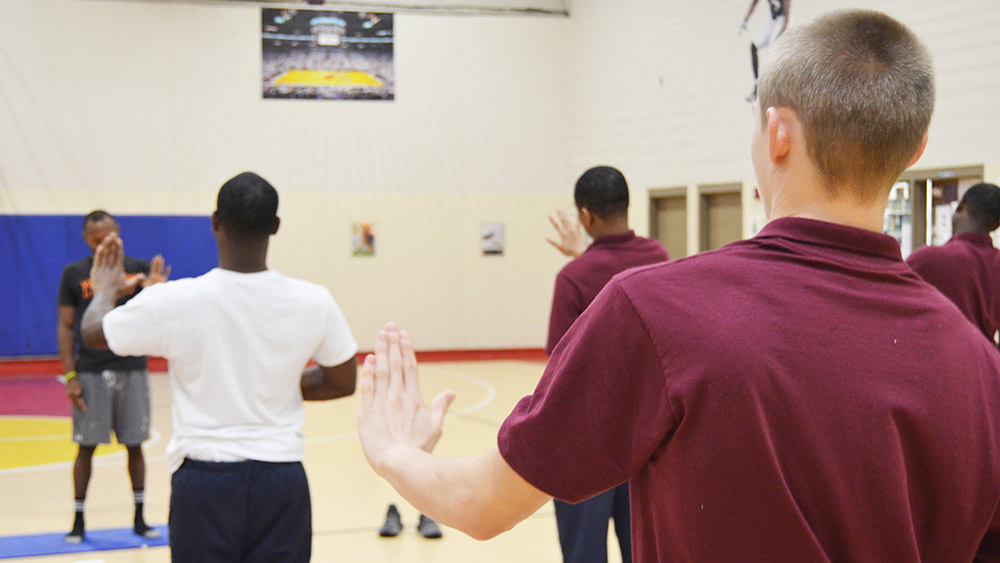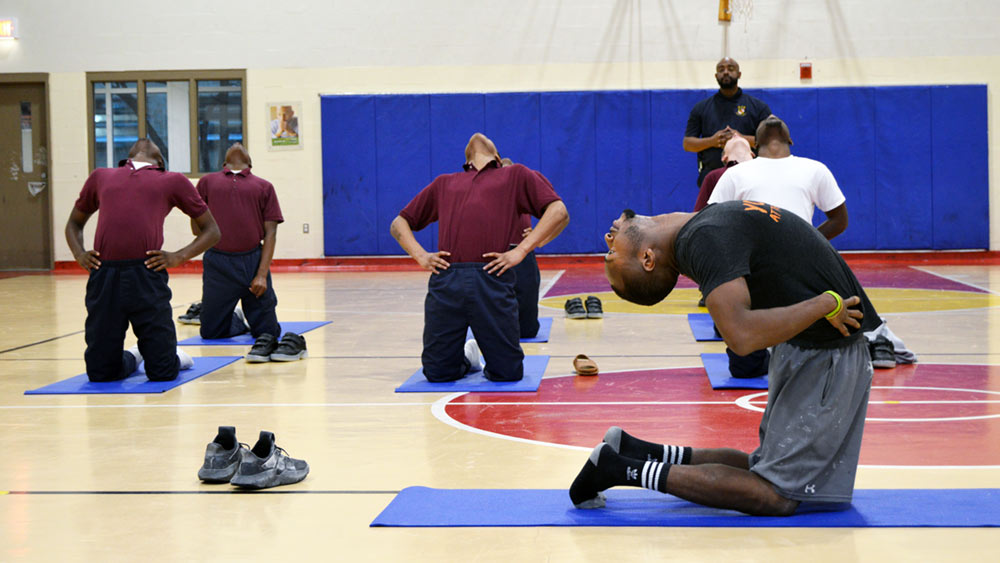
by Savannah Williams
Capital News Service
ANNAPOLIS, Maryland — Ten young men file into the gym, wearing identical maroon polos, white undershirts, navy sweats, white socks and black, laceless shoes. Soon, they’re removing those shoes and placing them behind 10 royal-blue yoga mats, rolled out on the basketball court floor.
The gym smells faintly of sweat and rubber, and life-size posters of Ravens football players are displayed around the room’s cinder block walls.
The two instructors lead the boys in slow, calming breaths, and show them how to roll their heads in lethargic circles to stretch and loosen up their necks.
“Do what’s comfortable for you,” one says.
If not for the guards, this could be any school gym — but the yoga and mindfulness class that’s about to begin serves boys in a secure detention center in Baltimore.
The young men living here are waiting to face their respective trials, or waiting to be placed at a treatment center — many of them haven’t yet been adjudicated, the equivalent of “convicted” in adult courts.
They inhale up, exhale down, inhale back, exhale forward, moving through sunrise salutations.
The boys who will be tried as juveniles usually stay in the Baltimore City Juvenile Justice Center for 20 days or fewer, while those who are waiting to be tried as adults, for more serious crimes, can stay for months.
In order to protect the identities of these juveniles, Capital News Service was not given any information on what offenses they are being accused of or why they may be awaiting treatment.
One 16-year-old boy from Baltimore, whose name is not being used, said he’d been at the center five months when interviewed on Sept. 25. He’s been in the yoga program, which rotates through the facility’s housing groups, for about a month and a half.
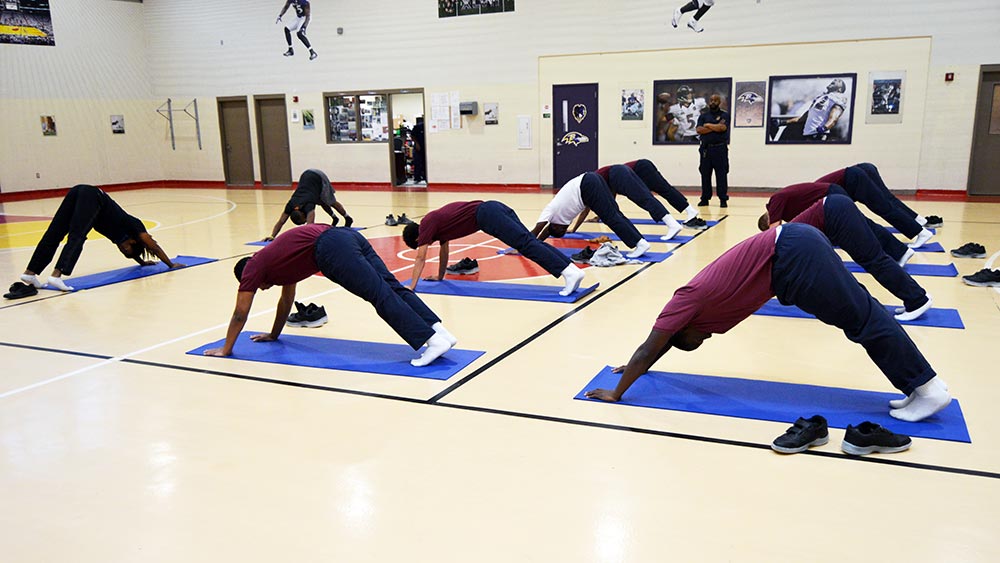
He said he initially wasn’t looking forward to the class.
“I thought it was gonna be boring,” the teen said. “It’s way better than I thought.”
He said the routines have gotten easier with more practice, and now he sometimes uses the breathing and stretching exercises outside of class.
“It helps me clear my mind, get my mind off the situation I’m in,” he explained.
The yoga program lasts six consecutive weeks, and rotates through the facility’s living unit groups. Not every boy who comes to the detention center gets to participate in the program.
The Baltimore City Juvenile Justice Center started offering yoga classes in the spring of 2017 according to Eric Solomon, a spokesman for the Maryland Department of Juvenile Services.
A Sept. 10 report from the Department of Juvenile Services said the average daily population of the Baltimore detention center was 103 boys.
About 98 percent were between 13 and 20 years old, according to the department’s 2017 resource guide.
The most common offenses reported in the 2017 guide at this center were robbery, narcotics distribution, automobile theft or unauthorized use, and second-degree assault.
Part of the class focuses on gratefulness meditation, where students lie on their backs with their eyes closed and focus on training their minds.
“Inhale, visualize someone or something you’re grateful for,” encourages Steven Carson, 30, one of the instructors. “When you exhale, think, ‘For this, I am grateful.’”
The Baltimore 16-year-old said when he does this exercise, he remembers his sister and both of his brothers.
Carson and the other teacher, Larry Jackson, 27, both of Baltimore’s Holistic Life Foundation, say the calming techniques yoga imparts to these youths are part and parcel for the practice, and that they don’t have to specifically gear their teaching to be more appropriate for the boys in the detention center.
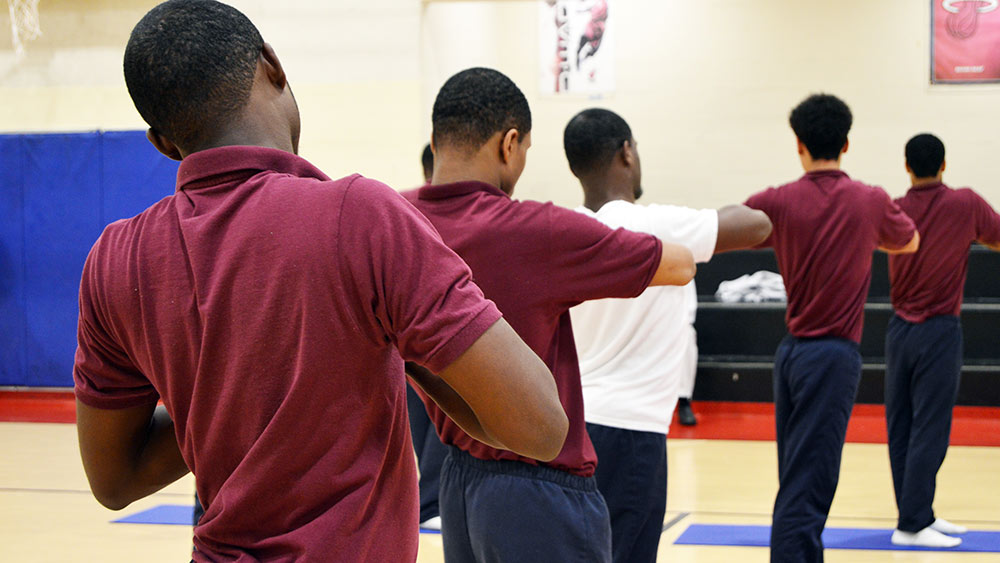
Jackson said the lack of distractions in the facility made teaching these boys even easier than at their after-school programs in the community, where if a student’s high school crush walks by, they start posing more to show off than to earnestly learn yoga.
“They can put more attention on what we’re doing here,” Jackson said.
Jackson and Carson have the boys lay on their backs and lift their legs straight into the air, and slowly lower them toward the floor, hovering just above the ground before repeating the action. Cords in the students’ necks show their strain.
“That was four?” asks Jackson, who was more occupied with giving tips on the exercise than counting.
A student laughs incredulously. “Dude that was like six,” he says.
Through the hour-long lesson, the boys never spoke out of turn, and even the three who had never had a lesson before were actively attempting to emulate Carson and Jackson.
The only sounds were the instructors’ voices, the guards’ walkie talkies, and the boys’ synchronized breathing — except when Jackson posed as though he was going to teach them a new exercise, and then abruptly broke out into song and dance. He was rewarded with a brief spurt of laughter.
“It seems like they really want to show that they can be good,” Carson said.
Both instructors — who also instruct after-school programs in the community — said this was their favorite class to teach.
Bill Brown, the national program director for Prison Yoga Project, an organization that trains instructors so they can lead yoga classes in jails and prisons, said yoga can treat issues of anger and trauma, so reaching these youths early in their lives could help set them on a better course.
“There’s a lot of emphasis placed on recognizing the feelings and sensations that you feel in your body, and developing resilience to stress,” Brown said.
He said even small things, like being able to choose whether to perform a specific pose that may be difficult, helped incarcerated people regain a sense of agency.
Yoga in prison is a trend on the rise, according to Brown.
He said it was difficult to track exactly how many prisons or jails participate, but he said that in addition to many U.S. states, the training program has spread to Canada, Mexico, Italy, Norway, the Netherlands, Sweden, the United Kingdom and Spain.
Anneke Lucas, the founder of Liberation Prison Yoga, a nonprofit organization based in New York, said yoga has many benefits for prisoners.
“The synchronicity of the breathing with the movement immediately engenders inner peace,” Lucas said. “That’s not to speak of the many physical and health benefits – (including) better sleep.”
She said she saw some of the most striking changes with participants who came in appearing depressed, and after several sessions, were behaving more lively and acting more hopeful.
Solomon said treatment is the main goal of the juvenile justice system, and that yoga and mindfulness training fit in perfectly with that goal.
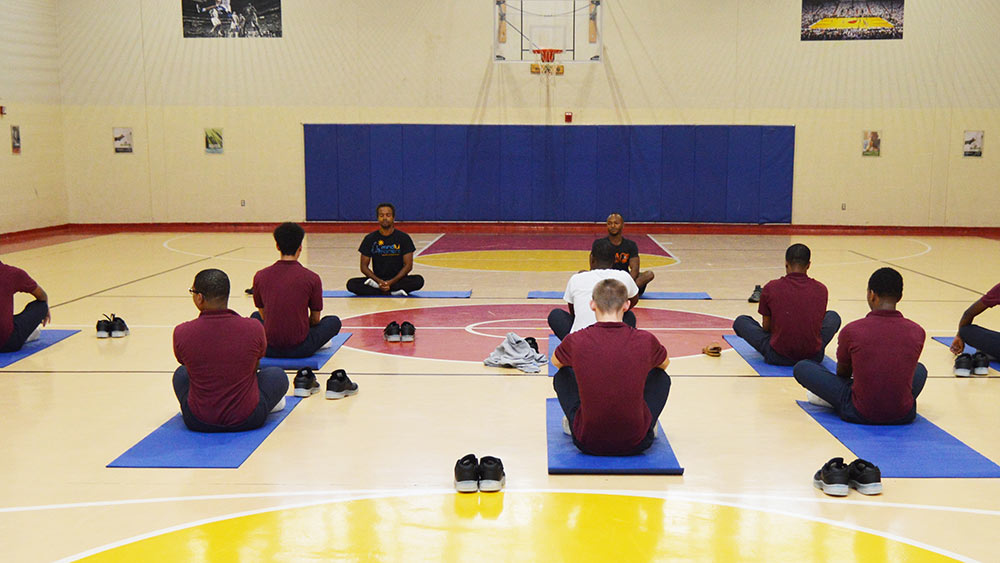
Solomon said the mindfulness program started at the Baltimore City detention center but has also spread to the Thomas J.S. Waxter Children’s Center, a Laurel, Maryland, girls’ secure detention center, in spring of 2017; the Victor Cullen Center, a boys’ secure treatment center in Sabillasville, Maryland, in May; and the J. DeWeese Carter Center, a girls’ secure treatment center in Chestertown, Maryland, in August.
The juvenile services department also offers yoga through the Baltimore Evening Reporting Center for youth in the community.
Another participant, also a 16-year-old boy from Baltimore, had just passed his two-month marker in the detention center and told Capital News Service he’d been participating in the yoga class there for most of that time.
The teen, whose name is also not being used, said he was familiar with the practice before he was incarcerated, even helping to teach elementary schoolers yoga in his community, but he enjoyed the exercise more in the detention center.
“It gets my mind off everything, helps me focus more,” the teen said. He said he puts his new skills to practice every morning when he wakes up.
Get PERKS and Support Community Journalism | SUBSCRIBE

